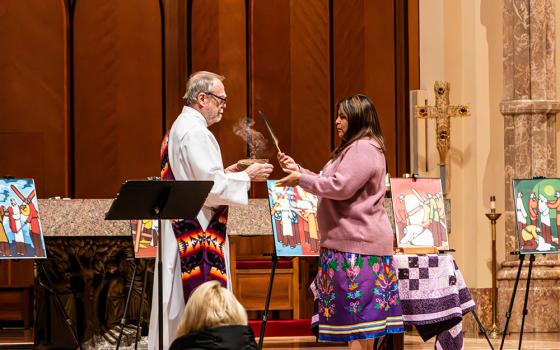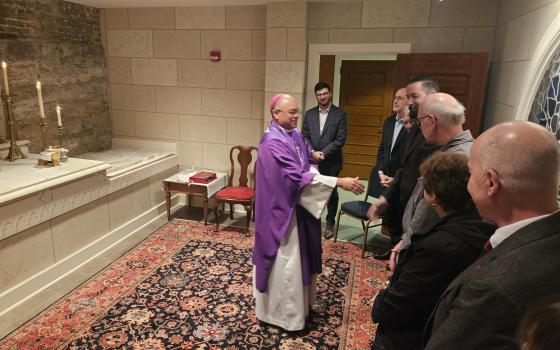Commentary
As I watch the back-and-forth between the Vatican and the Leadership Conference of Women Religious (LCWR), I’m struck by how the two sides are defining the concept of dialogue and its role in resolving Church conflict. Their starkly different views of that term were highlighted in the separate the interviews that Bishop Leonard Blair of Toledo, Ohio, and Franciscan Sr. Pat Farrell did with National Public Radio.
For Farrell, dialogue is about creating “a safe and respectful environment where church leaders along with the rank-and-file…can raise questions openly.” In Blair’s case, dialogue is a pathway for the LCWR to “remedy serious doctrinal concerns.”
In pondering these interviews, a question comes to mind: Which definition of dialogue is closest to Church tradition?
In her book “Field of Compassion,” the Catholic spiritual director Judy Cannato has a chapter on how theology gets made, focusing on Acts 15 and what is often called the First Church Council. It came about because some early followers in Judea were, writes Cannato, "teaching that Gentile believers must first become Jews" in order to properly follow Jesus. This triggered "no small discussion and debate" (Acts 15:2) between those followers and the disciples Paul and Barnabas, who didn't agree. The latter were dispatched to Jerusalem to meet with the apostles and other early Church elders about the issue. What transpired was the First Church Council.
In Jerusalem, Peter and James listen to both Paul and Barnabas, and those preaching adherence to Jewish law. Then they speak, first expressing happiness that Jesus’ message is being spread and accepted so widely. After that, they question why Gentiles should be made to jump through hoops when the Holy Spirit clearly came to everyone, regardless of their faith or background. Ultimately, Peter and James decide that as long as the Gentiles abide by some core Jewish prohibitions set down by Moses, they are welcome.
Acts 15, says Cannato, exemplifies how Catholic theology is made. "First, it is rooted in human life, the daily experience of those whose intention it is to respond to the holy within the context of a human relationship with the risen Christ." She notes that Peter and James "did not appear to restrict the discussion, but allowed everyone involved in the matter to speak." In fact, the author of Acts makes a point about Peter and James keeping silent (Acts 15:12) until they had heard from everyone. "Then, and only then," writes Cannato, "after asking the difficult questions and entering into silence and discussion and debate, there came an interpretation -- as broad as possible so as to facilitate an experience of the risen Christ rather than restrict it." Says Cannato, "[t]his is the pattern of theological reflection at root in the very early days of the Church."
I'm not a theologian, but I am a discerning reader. I've read both Acts 15 and Cannato's discussion, and this is what I think. At the time of the First Council, the early Church was in a period of becoming, of evolution. Its apostles, disciples, elders and rank-and-file followers were breaking new ground. Not only were they not exactly Jewish anymore, but they were also joined by people who had never been Jewish, and had no intention of following Judaism in order to follow Jesus. Any time you have such a mixing of cultures and beliefs, you are bound to have conflict. That's a given. It's how you resolve that conflict that's important.
The early Church had a pretty clear idea regarding what constitutes dialogue and conflict resolution. Peter and James listened to everyone. They stayed silent. They gave equal weight to both tradition and scripture as well as what was actually going on out in the body of the Church. They thought broadly about the matter. In this way, their final theological decision had actual real-world applicability. It was rooted in lived experience and the testimony of those in the field. It was a living truth rather than a dead law.
As I watch things unfold between the Vatican and LCWR I can't help wishing that someone would send both sides a copy of Acts 15, as well as Judy Cannato's book. I think those words might prove illuminating for all involved.
[Kevin Aschenbrenner is a writer, poet and M.A. student at the Sophia Center at Holy Names University in Oakland, Calif. More of his work can be found at www.wordsintheworld.com.]
NCR will be reporting on the LCWR assembly all week. Previous reports:
- Outside LCWR meeting, victims allege abuse by sisters, Aug. 9
- Keynote: LCWR 'seed bed' for 21st century, Aug. 8
- LCWR 'gathers collective wisdom' of members to discern next steps, Aug. 8
- LCWR past presidents reflect on Vatican mandate, Aug. 7
- LCWR to determine course at next week's annual meeting, July 31
For related commentary see:
- The Vatican, LCWR, and Definitions of Dialogue By Kevin Aschenbrenner
- What LCWR teaches us about church leadership By Jamie L. Manson
- Are these sisters dangerous women? By Patrick T. Reardon
- The Second Vatican Council has already made us free By Robert Blair Kaiser



